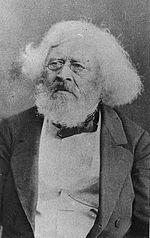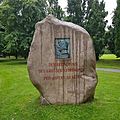Peter Andreas Hansen facts for kids
Quick facts for kids
Peter Andreas Hansen
|
|
|---|---|

Peter Andreas Hansen
|
|
| Born | 8 December 1795 Tønder, Schleswig
|
| Died | 28 March 1874 (aged 78) |
| Nationality | Danish |
| Known for | Hansen hypothesis |
| Awards | Gold Medal of the Royal Astronomical Society (1842, 1860) Copley Medal (1850) |
| Scientific career | |
| Fields | Astronomy |
Peter Andreas Hansen was a famous Danish-German astronomer. He was born on December 8, 1795, in Tønder, Denmark. He passed away on March 28, 1874, in Gotha, Germany. Hansen is best known for his important work on the Moon's movement and creating special tables to predict its position.
Contents
About Peter Andreas Hansen
Early Life and Start in Science
Peter Andreas Hansen was the son of a goldsmith. He first learned to be a watchmaker in Flensburg. He worked as a watchmaker in Berlin and Tønder from 1818 to 1820.
However, Hansen was always very interested in science. A doctor named Dr. Dircks helped convince Hansen's father to send him to Copenhagen in 1820. There, he met Heinrich Christian Schumacher, a famous astronomer. He even caught the attention of King Frederick VI.
Working at Observatories
From 1821 to 1825, Hansen worked as an assistant to Schumacher. He helped with a Danish land survey, mostly at the Altona Observatory.
After that, he became the director of the Gotha Observatory in Gotha, Germany. He stayed there for the rest of his career. He was invited to lead other famous observatories, but he always chose to stay in Gotha.
Studying the Planets and Moon
Hansen spent most of his time studying how gravity affects planets and moons. This field is called gravitational astronomy.
He studied how the planets Jupiter and Saturn pull on each other. This work won him a prize from the Berlin Academy in 1830. He also wrote about how comets are affected by gravity, which won a prize from the Paris Academy in 1850.
Hansen's Lunar Tables
One of Hansen's most famous achievements was his work on the lunar theory. This is about understanding and predicting the Moon's exact path. In 1838, he published a new way to study the Moon's movement.
Based on this work, he created improved "Tables of the Moon" in 1857. These tables were so good that the British government paid for them to be printed. They were used in important books like the Nautical Almanac starting in 1862. This helped sailors and astronomers know where the Moon would be at any time.
At first, astronomers thought Hansen's tables were perfect. But later, it was found that small differences started to appear between the predicted and actual positions of the Moon. Other astronomers, like Simon Newcomb and Ernest William Brown, later made even more accurate theories.
Other Important Discoveries
Hansen also visited Britain twice. He received the Gold Medal of the Royal Astronomical Society in 1842 and again in 1860. This is a very high honor for astronomers.
In 1850, he received the Copley Medal from the Royal Society. He also helped create "Solar Tables" in 1854, which predicted the Sun's position.
Hansen was the first to suggest that the accepted distance to the Sun was actually too far. He showed that earlier calculations had an error of millions of miles.
Later Life and Legacy
Peter Andreas Hansen passed away on March 28, 1874, at the new observatory in Gotha. He had helped build this observatory in 1857.
A minor planet in space, 4775 Hansen, is named after him to honor his contributions to astronomy.
Images for kids
See also
- Hansen's problem




